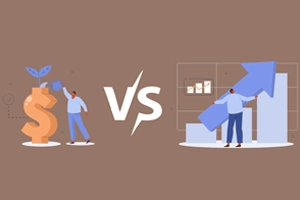
When it comes to investing, following a proper strategy is a must. Simply throwing your money into random investments may not yield the best results and might even lead to unnecessary stress. To keep things simple, there are two main investment strategies that you can follow - growth and value.
Value stocks vs growth stocks - Let’s break down each one so you can figure out which approach suits you best.
Understanding different investment strategies
- Growth investing: Growth investors look for companies that have the potential to grow faster than others. Investors who follow this strategy anticipate that these companies will continue to expand and deliver higher returns over time.
You can incorporate this strategy by either investing directly in growth stocks or via growth mutual funds that invest in growth stocks. - Value investing: In contrast, value investing focuses on finding companies that may be underpriced at the moment or going through a rough patch. These businesses might show slower growth now, but they have the potential to offer long-term value to investors.
Similar to the growth strategy, you can explore value mutual funds or invest in value stocks directly.
Difference between Value Stocks vs Growth Stocks
Aspect | Growth investing | Value investing | ||
Invests in | Companies with high growth potential |
| ||
Risk | High risk, with greater stock price volatility, especially in the short term | Low to medium risk, but still carries a chance of loss from the risk of misjudging a company’s potential recovery | ||
Expense | Typically, more expensive due to higher market demand
|
Generally, less costly, with stocks often priced at a discount | ||
Investment approach |
Targets companies with higher Earnings Per Share (EPS) or Earnings Before Income Tax and Depreciation (EBITDA) compared to others | Looks for mature companies with predictable revenues in established sectors Looks for mature companies with predictable revenues in established sectors |
Pros of Value Investing
- Less volatility: Value stocks tend to have steady prices and are a more stable option.
- Discounted values: You can find undervalued stocks and buy them for less than their intrinsic value and profit when the market corrects.
Cons of Value Investing
- Underperformance in bull markets: Value stocks often lag behind growth stocks when the market is booming, which could limit your gains.
- Slow strategy: Value investing requires some patience. These investments may take time to pay off. So, if you need quick returns, this strategy might not be ideal for you.
Pros of Growth Investing
- Potential for growth: Growth companies are often newer and have the potential to expand.
- Short-term opportunities: Due to their volatility, growth stocks may offer quicker returns in a shorter time frame.
Cons of Growth Investing:
- Hard to identify: It can be challenging to spot companies with the potential for growth. It requires a lot of experience to select industry winners. In many cases, investors miss out on opportunities due to a lack of experience and thorough research.
- High volatility: Growth stocks tend to experience sharp price drops during market downturns, which can increase your overall risk.
Value Stocks vs Growth Stocks - Which strategy is right for you?
There is no obvious champion between the two strategies. Both value and growth investing have their advantages and concerns, and the best choice depends on your personal goals and risk tolerance.
Value investing has helped many successful investors, including stalwarts like Warren Buffett, build wealth over time, but it also has some cons. The same goes for growth investing. While it can offer relatively better potential for rewards, it comes with higher risks.
As with all things in investing, personalisation is key. You must do your research and choose the approach that aligns with your financial goals and investment style.
Conclusion
Irrespective of whether you invest in growth or value stocks, it is crucial to first understand their pros and cons. This can help you make an informed decision. Additionally, you can also combine both strategies to create a more balanced and diversified portfolio that suits your needs.
An investor education initiative by Edelweiss Mutual Fund
All Mutual Fund Investors have to go through a one-time KYC process. Investors should deal only with Registered Mutual Fund (RMF). For more info on KYC, RMF and procedure to lodge/redress any complaints, visit - https://www.edelweissmf.com/kyc-norms
MUTUAL FUND INVESTMENTS ARE SUBJECT TO MARKET RISKS. READ ALL SCHEME-RELATEDDOCUMENTS CAREFULLY
Trending Articles
MUTUAL FUND INVESTMENTS ARE SUBJECT TO MARKET RISKS, READ ALL SCHEME RELATED DOCUMENTS CAREFULLY.















